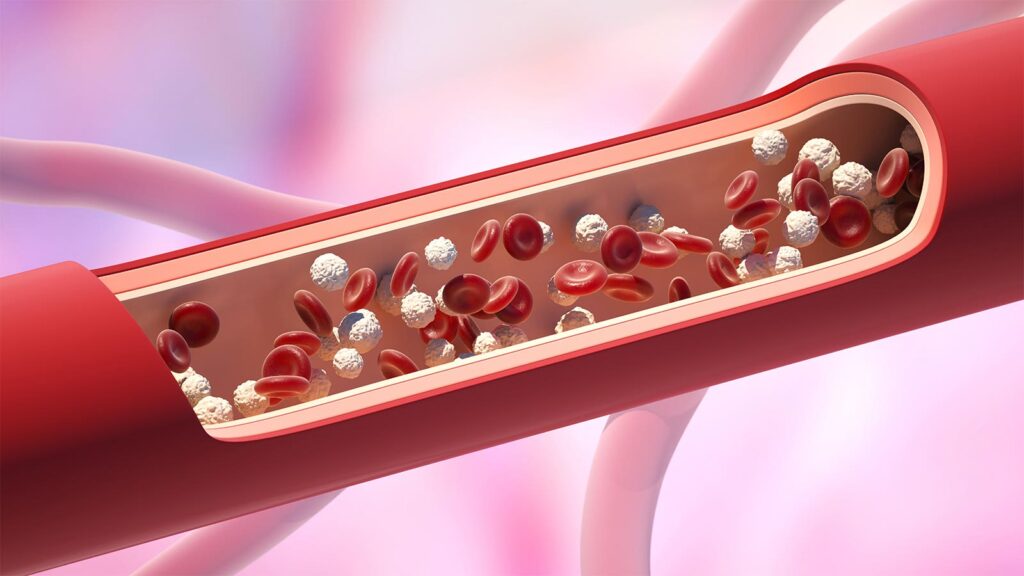Blood protein profiles predicted future dementia in healthy adults, a large longitudinal study showed.
Blood samples from over 50,000 people in the U.K. Biobank showed that four proteins — glial fibrillary acidic protein (GFAP), neurofilament light (NfL), growth differentiation factor-15 (GDF-15), and latent-transforming growth factor beta-binding protein 2 (LTBP2) — consistently were associated with subsequent all-cause dementia, Alzheimer’s disease, or vascular dementia over 14 years, according to Jin-Tai Yu, MD, PhD, of Fudan University in Shanghai, and co-authors.
Combining GFAP or GDF-15 with demographics led to an area under the curve (AUC) of 0.891 for all-cause dementia prediction, 0.872 for Alzheimer’s prediction, and 0.912 for vascular dementia prediction, the researchers reported in Nature Aging. Cognitive tests did not improve predictive power significantly.
People with higher GFAP levels were 2.32 times more likely to develop dementia, Yu and colleagues said. GFAP and LTBP2 were highly specific for dementia prediction, they added.
GFAP and NfL levels began changing at least 10 years before dementia diagnosis, with concentrations rising most steeply in people with all-cause dementia or Alzheimer’s.
Previous models to detect dementia risk depended largely on cerebrospinal fluid or imaging data, Yu noted. “The proteomic biomarkers are more [easy] to access and non-invasive, and they can substantially facilitate the application of large-scale population screening,” he said in a statement.
The study adds “to what we know about changes in blood that occur very early in diseases that cause dementia, which will be important for early diagnosis in the future,” wrote Tara Spires-Jones, DPhil, of the University of Edinburgh in Scotland, in a post on the U.K. Science Media Centre.
“However, it is important to note that these are still scientific research studies and that there are currently no blood tests available for routine use that can diagnose dementia with certainty,” Spires-Jones emphasized.
GFAP, a marker of astrogliosis, and NfL, a marker of axonal injury, have predicted dementia symptoms a decade before they emerged in an inherited form of Alzheimer’s disease. Plasma GFAP also has been proposed as a potential biomarker of Alzheimer’s-related pathologies.
The U.K. Biobank findings “appear robust given the knowledge we already have about GFAP being highly associated with Alzheimer’s disease and NfL not being specific for any one dementia,” Amanda Heslegrave, PhD, of University College London, posted on the Science Media Centre site. “[T]he message to take away here is that, for accurate diagnosis and differentiation between dementias, we need focused panels of biomarkers.”
Yu and colleagues used data from the prospective U.K. Biobank cohort to assess 1,463 plasma proteins. Blood samples were collected between 2006 and 2010. Baseline median age was 58. About 54% of the cohort was female and 94% was white.
The study included 52,645 participants without baseline dementia. Over a median follow-up of 14.1 years, 1,417 people were diagnosed with dementia, including 219 incident cases within 5 years, 833 within 10 years, and 584 beyond 10 years.
The researchers combined the top protein markers associated with incident dementia and demographic variables like age, sex, education, and family history to produce a predictive model for dementia risk over 10 years. They trained the model with data from two-thirds of the cohort (35,096 people) and tested its performance using data from the remaining third.
For 10-year risk, GFAP combined with demographic characteristics predicted all-cause dementia (AUC 0.872) and Alzheimer’s disease (AUC 0.847). Plasma GDF15 combined with demographic characteristics predicted 10-year incident vascular dementia with an AUC of 0.895.
Besides dementia, no significant association emerged between baseline GFAP and risks of other neurodegenerative diseases (HR 1.06, 95% CI 0.94-1.20, P>0.999), neurological disorders (HR 0.94, 95% CI 0.88-1.00, P=0.493) or mental and behavioral disorders (HR 1.05, 95% CI 0.95-1.15, P>0.999), “indicating that GFAP may be specific for dementia,” Yu and co-authors suggested.
The study had several limitations, the researchers noted. Plasma amyloid and tau-related proteins were not included in the analysis. Dementia incidence was lower than what other cohorts have reported, most likely because U.K. Biobank participants were younger at enrollment. The findings also have not been validated in an independent, external cohort.
-
Judy George covers neurology and neuroscience news for MedPage Today, writing about brain aging, Alzheimer’s, dementia, MS, rare diseases, epilepsy, autism, headache, stroke, Parkinson’s, ALS, concussion, CTE, sleep, pain, and more. Follow
Disclosures
Researchers were funded by the National Key Research and Development Program of China, the Science and Technology Innovation 2030 Major Projects, National Natural Science Foundation of China, Research Start-up Fund of Huashan Hospital, Excellence 2025 Talent Cultivation Program at Fudan University, Shanghai Municipal Science and Technology Major Project, and Shanghai Pujiang Talent Program.
The researchers declared no competing interests.
Spires-Jones and Heslegrave reported no conflicts of interest.
Primary Source
Nature Aging
Source Reference: Guo Y, et al “Plasma proteomic profiles predict future dementia in healthy adults” Nat Aging 2024; DOI: 10.1038/s43587-023-00565-0.
Please enable JavaScript to view the

